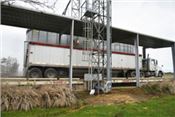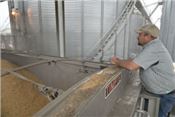|
Planting Season Rolling Along Despite Coronavirus Closures

A trailer is loaded with rice that had been stored in grain bins
at Christian Richard’s farm in Vermilion Parish.
Photo by Bruce Schultz/LSU AgCenter
BATON ROUGE, LA.
Many schools and workplaces have closed up shop amid the coronavirus pandemic. But in the world of agriculture, the show must go on. In Louisiana, this is rice and corn planting season – a busy and important time of year for farmers, who also will soon begin planting other crops such as soybeans and cotton.
“We’re wide open,” said Jason Waller, who grows rice, corn and soybeans in Mer Rouge in northern Louisiana. “They don’t let us take off from work or let us stop. Everybody’s got to eat.”
“Everything’s a go right now as far as corn planting is concerned in Louisiana,” said LSU AgCenter corn specialist Dan Fromme.
Corn farmers just started planting last week, with only about 5 percent to 10 percent of the state’s corn in the ground so far, Fromme said. He predicts Louisiana will have 550,000 to 600,000 acres of corn this year – a slight increase from 2019.
Farmers in some areas have been hindered not by coronavirus-related problems but by a more familiar foe: the weather. Rain has made many fields too wet for operating planting equipment.
“Most of the farmers I’ve talked to have had to jump around a little bit to find some dry ground,” Fromme said.
“We need dry weather badly,” said Waller, who is planting corn now and struggling with wet ground conditions. “The weather has just not been very cooperative this year.”
It’s important to plant during optimum windows; delays can prevent crops from performing to their fullest potential. For corn, ideal planting dates range from Feb. 25 to March 23 for southern Louisiana and March 24 to April 22 for the northern half of the state.
As time goes by and temperatures heat up, “we begin to slowly lose yield,” Fromme said.
Farmers are putting rice in the ground and gearing up to plant soybeans – crops that covered about 415,000 acres and 1 million acres, respectively, last year in Louisiana.
“We’re doing what we normally do – just another day,” said Mike Hundley, an Acadia Parish rice, soybean and crawfish producer. He has finished planting about half of his rice.
Despite closures and uncertainty worldwide, farmers are continuing to do their part in an industry that’s worth $11.7 billion to the Louisiana economy and that helps feed and clothe people around the globe.
“Farmers have got to put the seed in the ground. That’s how they make a living,” Fromme said. “Luckily, at this time of year, farmers are not around a whole lot of people – mainly just themselves and a few of their workers. They don’t really have much time to go out and interact with many people. They’re out in the fields. And then at night, they go back home. That’s pretty much the routine they have this time of year.”
Christian Richard, who farms rice, soybeans and crawfish in Vermilion Parish, said his farming operation is continuing with no interruption, although he’s concerned about the glut of crawfish on the market with restaurants closing.
Richard said he has more than half of his rice planted, and he will follow that with soybean planting. In the meantime, he’s loading truckloads of rice from last year’s crop that he recently sold.
Mike Salassi, AgCenter associate vice president, said research and outreach activities that support farmers and other clientele will continue during the coronavirus shutdown.
“Our research stations remain open with essential personnel to carry out necessary operations,” Salassi said. “Parish offices are open but have restricted visitors for now, and agents are available by phone or email and will continue to work with the public throughout this time.” ∆

Vermilion Parish farmer Christian Richard watches rice being loaded into a trailer
he will haul to a local rice mill. The rice is from last year’s crop that he recently sold.
Photo by Bruce Schultz/LSU AgCenter
|
|